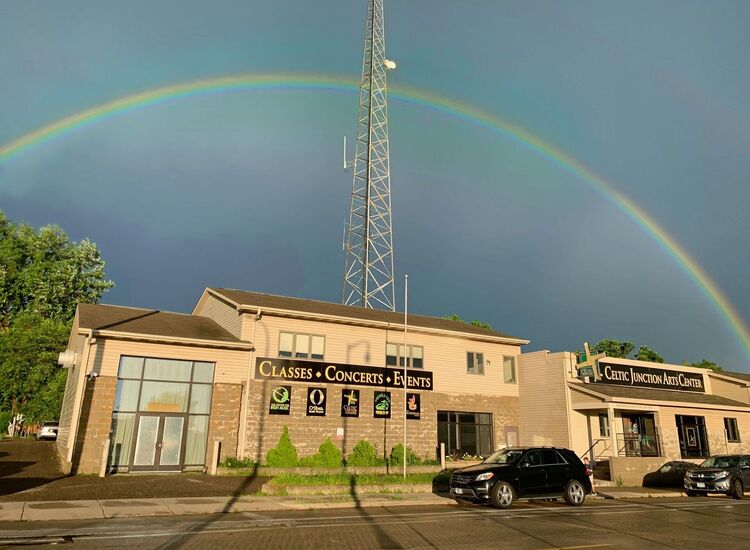By Jack Holland
In August, Ancient Rome was deserted, as its citizens fled the stifling summer heat to head for the cool surrounding hills. In Belfast, in July, the same thing occurs. Sensible citizens flee. But it is not the weather that drives them out. No. It is the sound of the Lambeg drum and the prospect of mayhem on the streets thanks to the "marching season."
You could say that Ulster's year is really divided into two seasons: the marching season and the non-marching season.
My father, when he was growing up near the Crumlin Road in North Belfast - a hard-core loyalist area in those days - felt the change of seasons particularly strongly, since he was a Catholic. Orange blood began to boil around the beginning of July, so his parents thought it best if he were transported to safety. They stuck him on a train for Newry, from where he was taken by his mother's relatives to Rostrevor, a few miles away on the coast of Carlingford Lough. He was safe there, in the foothills of the Mournes (the loveliest mountains in Ireland, for my money) until things got back to what passed for "normal" in dear ould Belfast.
My grandmother came from Kilbroney, just outside Rostrevor, and had nieces and nephews living there. Thus began my own acquaintance with the area. Nearly every summer, when school was finished, I could look forward to an escape to the Mournes or to the little village of Omeath, just across Carlingford Lough in County Louth.
So if I did not actually spend part of my summer in the Mournes I would spend it looking at them over the cold choppy waters of the fjord.
Rostrevor was a real village - one of the prettiest in the country. But Omeath was little more than a straggle of vendors' huts, a pub, a few cottages, and a quay where the ferry from Warrenpoint docked. The vendors sold those wonderful things that one always associates with the seaside - little windmills, fake binoculars made of plastic, pails and shovels, rubber hatchets and daggers, plastic swords, toy rifles that shot corks, and toy whistles. Other stalls sold willocks - tiny shell fish that you picked out with a pin. You could buy them in jars already picked and pickled.
Forty years or more ago, there was but one pub in the "downtown" part of the village, right near the quay. I would sit and guzzle gallons of lemonade and munch on crisps while my father and my uncle Willy would take their time over a bottle of porter. There was not much else to do in Omeath in those days. You could not swim in Carlingford Lough, the water was always freezing, even at the height of summer, and the beach was little more than a narrow stretch of seaweed-covered rock.
Our cottage was about five miles out of the village on the road to Carlingford town. It sat facing toward the lough up a long, stony laneway. It was in fact a small, low farm house, with two bedrooms off of a main room. There was an outhouse next to the house and no electricity. We used oil lamp. The most exciting thing about it was the bats, swooping down at night as we trudged back up the laneway, threatening (so we thought) to get tangled up in our hair. Apart from the outhouse, the most disgusting things were the black beetles, or clocks, as we called them, perhaps because during mating season they made a sort of ticking noise. On one of our very first trips there, about 1950 or so, I remember my grandmother lighting the oil lamp to behold a swarm of them marching across the walls and ceiling. I guess it was their marching season as well.
The nearest cinema was in Carlingford town. As well, King John's castle stood just outside the town, near the shore, guarding the entrance to the lough. My favorite thing, however, were the jaunting cars, which ran along the Omeath road. My granny and I would sit on the side seat with a blanket over our laps, bouncing along to the clip-clop of the horse's hooves. Perhaps my next favorite attraction in Omeath was the fact that you could buy American comics, which were not available in Northern Ireland. There were "horror" comics, which the British deemed too tasteless for children. But I loved them because they were glossier than the British comics, which appeared rather staid in comparison.
Finally, of course, there was the trip across the lough itself, which we took when we were staying in Rostrevor and wanted to visit Omeath for a day. The open boat left Warrenpoint, about three miles from Rostrevor, and took no more than 10 minutes to reach its destination. On the way across, a man sitting in the stern would play an accordion to entertain the day trippers as we skimmed over the waves.
Carlingford Lough is a rather forbidding stretch of water - dark and deep and cold and looking like it should hold a monster in its depths. And the Coolley Mountains above Omeath are equally dark and brooding, covered in bog and bare rock, with nothing but crows flocking above them and hares darting across their slopes. However, as refugees from the Glorious Twelfth, we deeply appreciated a landscape without a bowler hat or Lambeg drum in sight, even if it had been as bleak as that of the moon.
Assembly bad manners
The Assembly met last Wednesday, with the extraordinary sight of the 18 Sinn Fein members taking their seats and sitting under the same roof as the Rev. Ian Paisley. Gerry Adams began his address in Irish and I wondered if that was the first time in the history of Stormont that the Irish language has been spoken in its chamber. The Paisleyites were guffawing during the occasion, and when asked to behave themselves, Paisley quipped, "I'd pay more attention if I knew what he was taking about," much to the amusement of the other political Neanderthals about him. Such is the famed Ulster wit. Still, it was far from being the worst display of bad manners that Ulster has experienced.








